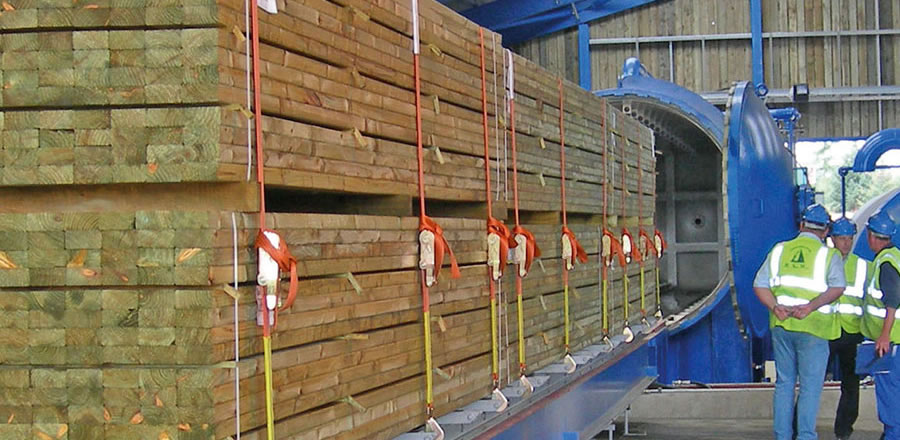CATEGORY

Here at Grangewood Fencing Supplies, the majority of the timber that we supply is Pressure Treated Timber. We supply Tanalith E treated timber which is pale green in colour and Tanatone treated timber which is brown. The following article explains just exactly what these terms mean.

Main features of Pressure Treated Timber
Tanalised E pressure treated timber has been impregnated with Tanalith E wood preservative under controlled conditions in a vacuum pressure impregnation plant.
When treated to the appropriate specification, Tanalised E pressure treated timber is protected against fungal decay (rot) and insect attack to ensure an extended service life to the timber.
Following impregnation, the preservative bonds with the wood structure such that it cannot easily be removed from the timber.
Tanalith E wood preservative is registered and cleared for use under the UK Control of Pesticides Regulations. The preservative contains copper and triazole biocides.
Typical uses for Tanalised E pressure treated timber include general construction, cladding, garden and leisure wood structures, fencing and playground equipment.
Tanalised E pressure treated timber is available with built-in brown colour – Tanatone pressure treated timber.
The treatment process
Before the treatment process begins, the timbers are prepared to ensure they are dried to a suitable moisture content. Once this has been achieved, the timber undergoes the following 5 steps:
- The timber is loaded into a large treatment tank where an initial vacuum is applied.
- Under vacuum, the tank is then completely flooded with TANALITH E wood preservative.
- Whilst full, hydraulic pressure is then applied inside the tank which forces the preservative deep into the timber. (The period of time which pressure is applied is dependent on the species of timber being treated).
- The remaining treatment is then pumped back into storage and a final vacuum extracts any excess preservative solution, which is also pumped back.
- The door is then opened and low pressure inside the timber draws in any remaining surface preservative solution. Following this, the timber is virtually dry.
Handling precautions
When working with timber, wear gloves to protect the skin from abrasions and splinters. A waterproof dressing should be used to protect any cuts and abrasions.
When power-sawing and machining, wear goggles to protect the eyes from flying particles. Wear a dust mask and, whenever possible, perform these operations outdoors to avoid accumulations of airborne sawdust.
Avoid frequent or prolonged inhalation of sawdust. Consult HSE Guide EH40, available on the HSE website (www.hse.gov.uk), for further information on workplace exposure limits for wood dust.
Care should be taken when lifting or moving timber, in order to prevent injury.

Personal hygiene
The skin should be washed before commencing other activities after handling or working with treated timber. If sawdust accumulates on clothes, clean them before reuse. Launder heavily soiled clothes separately from other household wash items.
End-use considerations
Tanalised E pressure treated timber can be used in internal and external building applications and outdoors, both in ground contact and above the ground, without any need for further protection.
Tanalised E pressure treated timber is treated to meet the requirements of a particular end use. This end-use suitability should be confirmed by the supplier of the treated timber. When specifying timber for exterior situations, either treated or untreated, consideration should be given to the propensity of the material to stain light coloured adjacent faces, such as render, paving flags or coated timber surfaces, with its natural extractives during the weathering process. This staining effect can be highlighted where Tanatone treated timber has been selected. However, the potential for this to occur does reduce over time.
Where used in this type of external environment, it is highly recommended that any contact between the timber and these surfaces is eliminated by design. This will help to prevent surface discolouration. Treated timber should not be used where it may come into contact with drinking water or for food preparation areas.
When considering the use of Tanalised E pressure treated timber around fish-ponds, please contact Arch Timber Protection for advice.
On-site precautions and waste disposal
All sawdust and construction debris should be cleaned up and disposed of after construction.
Tanalised E pressure treated timber is not classified as hazardous waste. However, post-treatment processing wastes, such as sawdust and offcuts, must not be used for animal litter or bedding.
Tanalised E pressure treated timber should not be used for fuel in barbecues, cooking stoves or grates. Householders should dispose of timber, sawdust or ash through the ordinary waste collection/disposal service. Any waste timber, sawdust or redundant timber from commercial or industrial use (e.g. construction sites) should be recycled by re-use, or disposed of to an authorised landfill or to a correctly controlled and approved waste incinerator.


